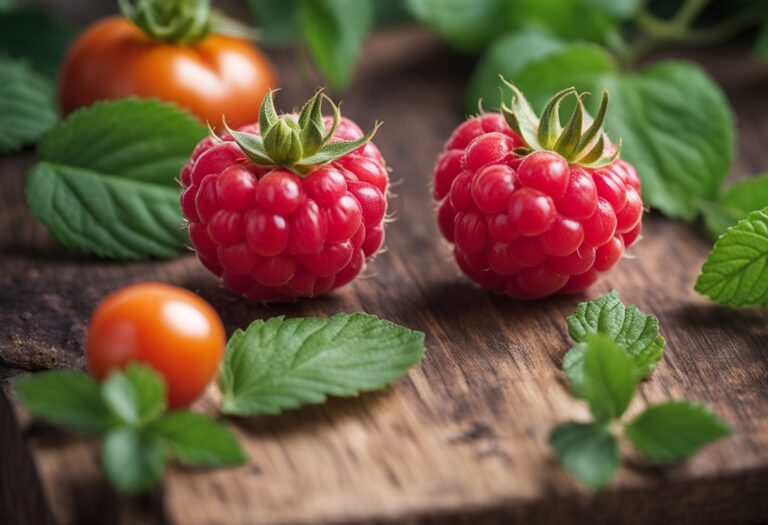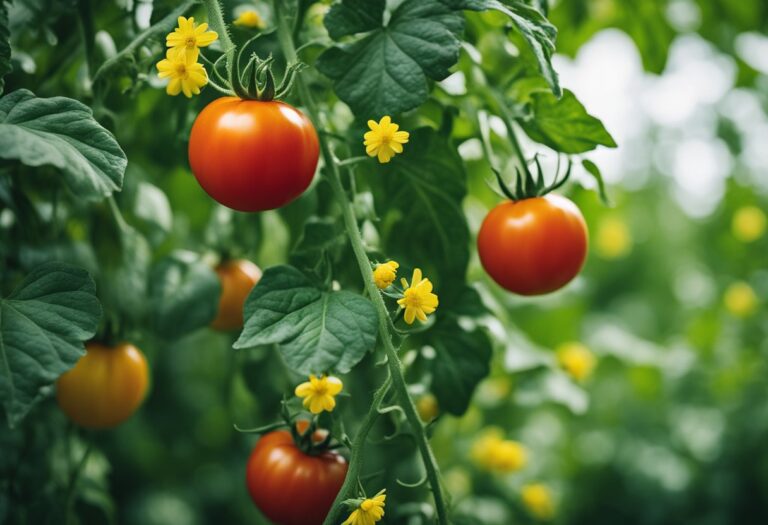Tomato Pruning Mistakes: Common Errors to Avoid
If you’re a gardener, you know that pruning is an essential part of growing healthy, productive plants. However, when it comes to pruning tomatoes, it can be easy to make mistakes that can hinder the growth and yield of your plants. In this article, we’ll explore some common tomato pruning mistakes and how to avoid them.

Understanding Tomato Pruning Basics
Before we dive into the mistakes, let’s review the basics of tomato pruning. Pruning is the process of removing certain parts of the plant to promote growth, improve health, and increase yield. For tomatoes, this typically involves removing the “suckers” or small shoots that grow in the crotch between the stem and a branch. By removing these suckers, the plant can focus its energy on producing bigger, better fruit.
Key Takeaways
- Proper tomato pruning involves removing suckers to promote growth and yield.
- Common pruning mistakes include improper timing and techniques, as well as neglecting plant health.
- Avoiding these mistakes can lead to healthier, more productive tomato plants.
Understanding Tomato Pruning Basics

If you’re new to gardening, pruning tomato plants can be intimidating. However, with a little knowledge and practice, you’ll be able to prune your tomato plants like a pro. In this section, we’ll cover the basics of tomato pruning, including the purpose of pruning and different pruning techniques.
The Purpose of Pruning
The main purpose of pruning tomato plants is to encourage healthy growth and increase fruit production. By removing excess foliage, you can improve air circulation around the plant, which helps prevent diseases. Pruning also allows the plant to focus its energy on producing fruit rather than growing unnecessary foliage.
Different Pruning Techniques
There are several different pruning techniques you can use on your tomato plants, depending on the type of plant and your personal preferences. Here are a few common techniques:
-
Removing Suckers: Suckers are small shoots that grow between the main stem and the branches of the plant. Some gardeners remove all suckers, while others leave a few to help support the plant. Removing all suckers can increase fruit production, but it can also reduce the overall size of the plant.
-
Removing Lower Leaves: Removing the lower leaves of the plant can help prevent diseases and improve air circulation. However, you should never remove more than one-third of the plant’s leaves at once.
-
Pruning to a Single Stem: This technique involves removing all branches and suckers except for the main stem. It can help increase fruit production, but it also requires more maintenance and support for the plant.
Remember, the key to successful tomato pruning is to start slowly and observe how your plants respond. With practice, you’ll be able to develop your own pruning style and help your tomato plants thrive.
Common Pruning Timing Errors

When it comes to tomato pruning, timing is everything. Pruning too early or too late can have negative effects on your tomato plants and lead to poor yields. In this section, we’ll discuss two common pruning timing errors and how to avoid them.
Pruning Too Early
Pruning your tomato plants too early can stunt their growth and reduce their overall productivity. If you prune your plants before they have grown enough, you risk removing important foliage that the plant needs to produce energy through photosynthesis. This can lead to a weaker plant that is more susceptible to disease and pests.
To avoid pruning too early, wait until your tomato plants have grown at least 6 to 8 inches tall and have developed their first set of true leaves. At this point, you can begin pruning the suckers that grow between the main stem and the branches.
Pruning Too Late
Pruning your tomato plants too late can also have negative effects on their growth and productivity. If you wait too long to prune your plants, they may become too bushy and dense, which can reduce air circulation and increase the risk of disease.
To avoid pruning too late, pay close attention to your tomato plants and look for signs that they are becoming too dense. If you notice that your plants are becoming too bushy, start pruning the suckers and removing any excess foliage. This will help to improve air circulation and prevent disease.
Overall, timing is key when it comes to tomato pruning. By avoiding these common timing errors, you can ensure that your plants grow strong and healthy, and produce a bountiful harvest.
Improper Pruning Techniques
When it comes to tomato pruning, there are several techniques that can do more harm than good. In this section, we’ll discuss the most common improper pruning techniques and how to avoid them.
Over-Pruning
Over-pruning your tomato plants can lead to sunscald, which occurs when developing fruits are exposed to full sun. In an effort to speed up the ripening process, you may think it’s a good idea to clip out all the leaves surrounding the green tomatoes on your plant. However, this can be detrimental to the plant’s health.
To avoid over-pruning, only remove the leaves that are blocking sunlight from the ripening fruit. It’s also important to leave enough foliage on the plant to protect the fruit from sunscald.
Under-Pruning
On the other hand, under-pruning your tomato plants can lead to a lack of airflow and an increased risk of disease. If you don’t remove enough foliage, the plant can become too dense, which can also lead to a lack of sunlight reaching the lower parts of the plant.
To avoid under-pruning, regularly remove suckers and lower leaves to promote good airflow and direct energy towards fruit production. Remember to start at the bottom of the plant and work your way up.
Incorrect Cutting Methods
Using incorrect cutting methods can also harm your tomato plants. For example, tearing or ripping the leaves or stems can damage the plant and increase the risk of disease. It’s important to use sharp, clean pruning shears and make clean cuts at a 45-degree angle.
To avoid incorrect cutting methods, make sure your pruning shears are sharp and clean before each use. It’s also important to disinfect your pruning shears with rubbing alcohol between plants to prevent the spread of disease.
By avoiding these common improper pruning techniques, you can help your tomato plants thrive and produce a bountiful harvest.
Neglecting Plant Health During Pruning
When pruning your tomato plants, it’s important to keep the overall health of the plant in mind. Neglecting plant health during pruning can lead to various issues down the line, including disease and pest problems. In this section, we’ll discuss two common mistakes that can lead to plant health issues during pruning.
Ignoring Disease and Pest Issues
One mistake that gardeners often make when pruning tomato plants is ignoring any existing disease or pest problems. If your tomato plant is already struggling with a disease or pest issue, pruning can exacerbate the problem by stressing the plant and creating more entry points for pests and diseases.
Before pruning, take a close look at your tomato plant and check for any signs of disease or pests. If you notice any issues, take care of them before pruning. This may involve removing infected leaves or treating the plant with an appropriate pesticide. By addressing any existing issues before pruning, you’ll help ensure that your plant stays healthy and strong.
Failing to Sanitize Tools
Another mistake that can lead to plant health issues during pruning is failing to sanitize your tools. When you prune your tomato plants, you create open wounds on the plant that can be entry points for diseases. If your pruning tools are not properly sanitized, you can inadvertently spread disease from one plant to another.
To avoid this problem, be sure to sanitize your pruning tools before using them on your tomato plants. You can do this by wiping the blades with rubbing alcohol or a 10% bleach solution. By taking this simple step, you’ll help prevent the spread of disease and keep your plants healthy.
In summary, neglecting plant health during pruning can lead to a variety of issues, including disease and pest problems. By taking the time to address any existing issues and sanitize your tools, you’ll help ensure that your tomato plants stay healthy and productive.
Consequences of Pruning Mistakes
When it comes to tomato pruning, mistakes can have serious consequences for your plants. If you make the wrong cuts or prune at the wrong time, you can end up with reduced fruit yield and compromised plant vigor.
Reduced Fruit Yield
One of the most common consequences of pruning mistakes is reduced fruit yield. When you prune your tomato plants too much or at the wrong time, you can remove the very shoots that produce fruit. This can lead to fewer tomatoes overall, and smaller fruits that don’t ripen as well.
To avoid this problem, make sure you’re pruning your tomato plants properly. Use clean pruning tools and avoid over-pruning. If you’re not sure how much to prune, start with just a few leaves or stems and see how your plants respond.
Compromised Plant Vigor
Another consequence of pruning mistakes is compromised plant vigor. When you prune your tomato plants too much or at the wrong time, you can weaken the plant and make it more susceptible to disease and pests. This can lead to stunted growth, yellowing leaves, and even death in severe cases.
To keep your tomato plants healthy and vigorous, make sure you’re pruning them properly. Avoid pruning too much at once, and make sure you’re not removing too many leaves or stems. Keep an eye on your plants and watch for signs of stress or disease, such as wilting or yellowing leaves.
By avoiding these common pruning mistakes, you can help your tomato plants thrive and produce a bountiful harvest. Remember to always use clean pruning tools, prune at the right time, and avoid over-pruning to keep your plants healthy and strong.
Frequently Asked Questions
When is the best time to start pruning tomato plants?
The best time to start pruning tomato plants is when they are about 12-18 inches tall and have at least two sets of true leaves. It is important to start pruning early to encourage strong growth and prevent the plant from becoming too bushy.
Can you describe the proper technique for pruning tomato plants?
To properly prune tomato plants, you should start by removing the suckers that grow in the crotch between the stem and branches. Use clean, sharp shears to make a clean cut. You should also remove any yellow or diseased leaves. Be careful not to remove too much foliage, as this can reduce the plant’s ability to produce fruit.
What are the consequences of over-pruning tomato plants?
Over-pruning tomato plants can reduce the plant’s ability to produce fruit and can also make the plant more susceptible to disease. It is important to only remove the suckers and leaves that are necessary to promote healthy growth.
Are there specific tomato varieties that should not be pruned?
Most tomato varieties can be pruned, but some determinate varieties should not be pruned as heavily as indeterminate varieties. It is important to research the specific variety of tomato you are growing to determine the best pruning technique.
How can pruning affect the yield of tomato plants?
Pruning can increase the yield of tomato plants by directing the plant’s energy towards producing fruit instead of foliage. However, over-pruning can reduce the plant’s ability to produce fruit.
What are the key parts of a tomato plant that should be pruned for optimal growth?
The key parts of a tomato plant that should be pruned for optimal growth are the suckers that grow in the crotch between the stem and branches, as well as any yellow or diseased leaves. It is important to only remove the foliage that is necessary to promote healthy growth and fruit production.


